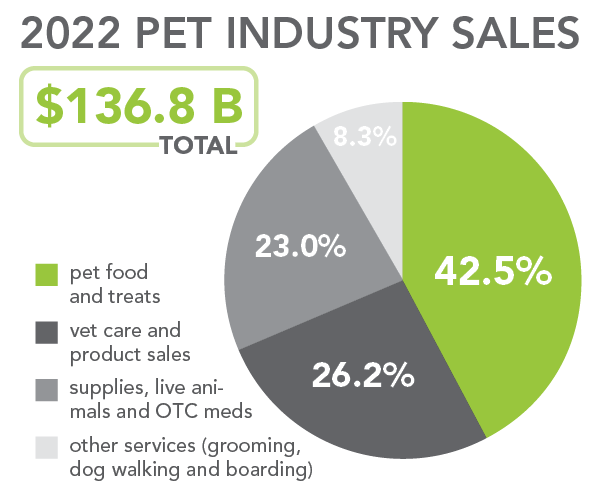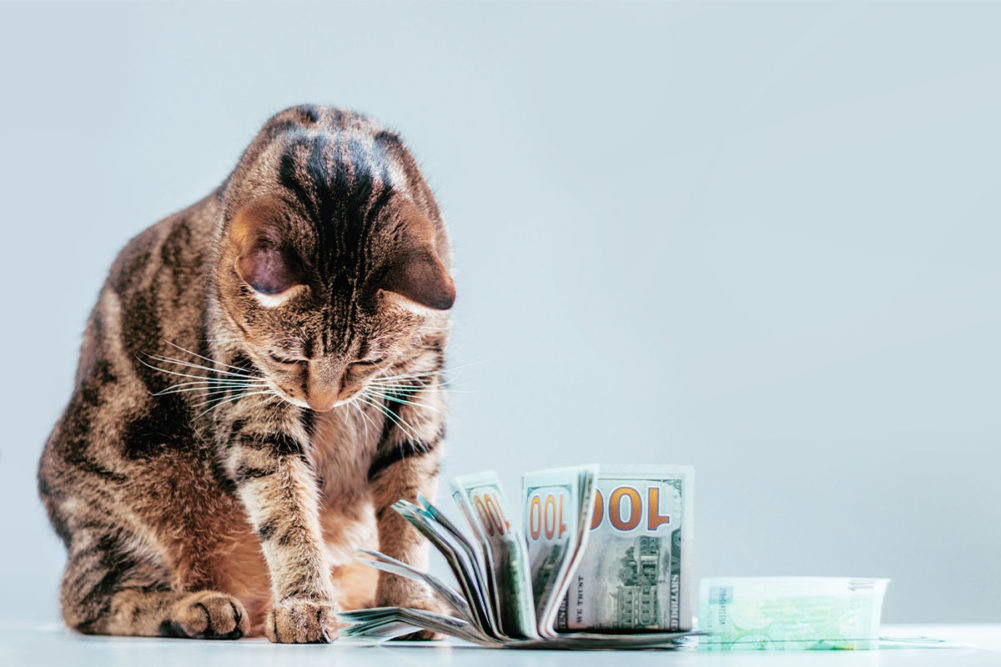STAMFORD, CONN. — A look in the rear-view mirror proves 2022 was no walk in the park for the pet care and products industry. But despite various disruptions and challenges, last year’s sales numbers paint a profitable picture and illustrate a bright future for years to come.
According to the American Pet Products Association’s (APPA) 2022 State of the Industry data, total pet industry sales topped $136.8 billion in 2022, representing an increase of 10.8% from 2021. This includes pet food and treats, veterinary care and products, supplies, live animals, over the counter (OTC) medications, and other services.
“Pet spending in 2022 was up nearly 11% from the previous year,” said Peter Scott, president and chief executive officer of APPA. “While we outperformed our 2022 forecast, we know this increase can be attributed in large part to higher than anticipated inflation, and we expect spending will follow a similar trajectory and remain steady in 2023. Along those same lines, we saw pet ownership normalize and return to pre-pandemic levels, which is not surprising given the uptick we saw in pet acquisition as a result of the pandemic.”
APPA premiered its most recent State of the Industry data at Global Pet Expo on March 23, held at the Orange County Convention Center in Orlando, Fla.
 Source: American Pet Products Association (APPA), 2022 State of the Industry
Source: American Pet Products Association (APPA), 2022 State of the Industry As in years past, pet food and treat sales represented the highest spend category in 2022, totaling $58.1 billion (42.5% of total industry sales), up a solid 16.2% over 2021.
The next highest spend category was vet care and product sales, landing at $35.9 billion (26.2% of total industry sales) in 2022, up 4.7% from 2021. Coming in third was the supplies, live animals and OTC meds category, which accounted for $31.5 billion in sales (23% of total industry sales), an increase of 5.7% from 2021.
The lowest spend category — still reaping $11.4 billion in sales in 2022 — was other services, which includes grooming, dog walking and boarding. While this category only made up 8.3% of total industry sales last year, it saw the highest year-over-year increase in spend at 20% above 2021.
“Overall, we are excited to report all signs continue to point to the strength of the industry,” Scott said.
APPA’s 2023-2024 National Pet Owners Survey, which also debuted at Global Pet Expo, revealed several key trends influencing the evolution of the industry.
“While pet ownership has normalized somewhat, the most recent version of the National Pet Owners Survey reveals some very interesting trends that will have significant implications for the industry this year and beyond,” said Anne Ferrante, senior vice president of member relations and business development at APPA. “This includes differences in pet ownership by generation, the effect of the economy on spending, shifts in where people are acquiring pets, trending product categories and more.”
According to the survey, the number of US households that own at least one pet is now 86.9 million, making up 66% of households nationwide. This pet ownership is now reflected equally among younger and older generations of pet owners; for the first time, APPA reported, the number of Gen Z and Millennial pet owners equals the number of Gen X and Baby Boomer pet owners across the country.
With these changing pet owner demographics comes changing pet ownership sentiments. For example, younger pet owners tend to spend more on their pets, but are also more likely to be concerned about pet ownership expenses, according to the report. For older generations of pet owners, their priorities lie in the maintaining their pets’ existing levels of care and focusing on the benefits pet ownership provides.
Regardless of generation, half of pet owners are willing to spend more money on products that fall under four key categories — made in the US, ethically sourced, BPA-free and eco-friendly. The survey showed 75% of pet owners are committed to their pets diet, while 56% are committed to brand loyalty. Additionally, the use of pet technologies — including monitoring systems and tracking devices — is rising steadily, with an increasing number of pet owners interested in purchasing products like these over the next year.
However, economic pressures continue to be a concern. According to APPA, 31% of pet owners considering pet supplies as discretionary purchases and planning to save money by lower their spending on these products. Roughly 66% of pet owners now take their pets’ needs into account during financial planning, reinforcing the concept of pets as part of the family.
The survey also found that in-person shopping for pet products remains a preference for nearly half of all pet owners, particularly Gen Xers and Boomers.
All in all, the data shared by APPA at this year’s tradeshow points to one thing: a healthy industry with opportunities abound.
Keep up with the latest pet food data and trends on our Trends page.




